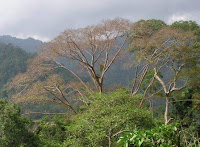New Year’s is a time when we reflect on past promises made, whether we achieved these goals, and what we need to do in the new year to improve ourselves.
We remember with great pride and happiness the promises that were made on 27 August 2005, the day Chief Minister of Selangor, together with the Deputy Prime Minister of Malaysia declared the establishment of Selangor State Park, as Taman Warisan Selangor.
Today, the Park is known as Taman Negeri Selangor, and will be 108,300 ha once completely gazetted.
Below, we recall the highlights of the speeches and promises made by both the Chief Minister of Selangor and the Deputy Prime Minister of Malaysia, on that auspicious day, over 5 years ago. Sadly, this location where the declaration occurred, is the same location that the KLORR is likely to cut through the Klang Gates Quartz Ridge, the key feature of the Park.
Teks Ucapan Pelancaran
YAB Timbalan Perdana Menteri Malaysia
Di Majlis Pelancaran Taman Warisan Selangor
Di Kawasan Rekreasi Empangan Klang Gates Ampang
Majlis Perbandaran Ampang Jaya
Pada 27 Ogos 2005
…….Konsentrasi dan kepesatan penduduk yang terdapat dan akan bertambah di Selangor dan Konurbasi Kuala Lumpur, jika tidak dirancang dengan sempurna, akan menimbulkan kesan negatif terhadap penduduk dan persekitaran fizikal dan sosio-ekonomi di wilayah ini, jika langkah-langkah pencegahan tidak diambil daripada sekarang. Diantara kerumitan yang dijanka wujud jika tidak dihindari ialah ketiadaan air minuman yang cukup, kualiti air sungai yang sangat rendah, pemotongan bukit dan penebangan pokok kerana pembukaan tanah untuk pembangunan, kepupusan fauna dan flora kerana kekurangan kawasan semula jadi, dan kekurangan kawasan lapang dan kawasan hijau sebagai ‘green lungs’ bagi kawasan Konurbasi Kuala Lumpur keseluruhannya….
Taman Warisan Selangor yang akan dilancarkan pada hari ini, yang terletak di sepanjang di sebelah timur negeri Selangor dan sangat hampir dengan sempadan Kuala Lumpur, merupakan kawasan warisan khazanah alam semula jadi bukan sahaja kepada rakyat negeri Selangor, tetapi juga kepada warga Kuala Lumpur dan Putrajaya. Taman Warisan Selangor ini merupakan sumber air bagi penduduk Selangor, Kuala Lumpur dan Putrajaya, dan dengan itu menjadi asas kehidupan penduduk konurbasi Kuala Lumpur. Ia akan melindungi tanah tinggi dan bercerun supaya tidak menghakiskan sungai-sungai yang bermula dari kawasan Taman Warisan ini….
Teks Ucapan
YAB Dato’ Seri Dr. Mohamad Khir Bin Toyo
Dato’ Menteri Besar Selangor
Di Majlis Pelancaran Taman Warisan Selangor
….Degan pengisytiharan kawasan ini sebagai Taman Warisan di bawah pengurusan perbadanan Taman Negeri Selangor, jaminan diberikan bahawa ia akan kekal hijau buat selama-lamanya apa juga berlaku kawasan in tidak akan dibangunkan…
Kita mahu Selangor maju dengan mengekalkan sekurang-kurang kehijauan pada tahap 30 peratus.
Taman ini bukan sahaja sejajar dengan Dasar Kepelbagaian Bio-diversiti Negara tetapi juga bagi menjamin kemapanan sumber asli serta melindungi kawasan-kawasan sensitif alam sekitar selari dengan komitmen kerajaan Negeri ke arah melaksanakan Agenda 21 Selangor….
Seperti yang kita sama-sama maklum, kawasan hutan (ini) dikenalpasti sebagai Kawasan Sensitif Alam Sekitar…
Kelima-lima sungai utama di Selangor…berpunca dari kawasan yang kini dikenali sebagai Taman Warisan Selangor ini. Dengan menjadikan kawasan hutan itu sebagai Taman Warisan yang tidak boleh diteroka, kita dapat menjamin bahawa kawasan tadahan air utama bagi Lembah Klang ini dilindungi buat selama-lamanya…
…kawasan Taman Warisan Selangor ini sangat kaya dengan spesis semula jadi…ada antara tumbuhan dan hidupan liar di dalam Taman ini dianggap sangat unik dan jarang ditemui. Dengan menjadikan kawasan seluas 107,000 hektar ini sebagai Taman yang dilindungi, maka kepelbagaian biologi yang terdapat didalamnya, dapat dijamin dari pupus buat selama-lamanya. Dengan itu, fungsi-fungsi ekologi flora dan fauna, serta pembentukan-pembentukan geologi kawasan itu, akan kekal mengikut hukum alam buat selama-lamanya…
Let's hope in 2011, these promises will be kept. Once again, Happy New Year!
If you would like a copy of the full speech, that was included in the press kit on the launch day, please email to treateveryenvironmentspecial@gmail.com.
If you would like a copy of the full speech, that was included in the press kit on the launch day, please email to treateveryenvironmentspecial@gmail.com.

















































